Text

Miku says trans rights! Donate $5 or more to the Trans Youth Equality Foundation and send me a screenshot HERE plus your address to get a trans Miku sticker in the mail.
reblogs appreciated!
28 notes
·
View notes
Photo

A still from ‘Negative Space’ by Ru Kuwahata and Max Porter
This 5 minute short is based on a Ron Koertge poem, it is a story of a man remembering packing his father’s suitcase after being taught the efficient way, he would await his father’s praise for packing the suitcase correctly. The father dies and as the man views his casket he is reminded of the suitcase and views the casket as ‘wasting space’. The mise en scene mirrors the narrative by utilising every space of the frame and there are some beautiful scenes of folding and arranging of items. The puppets and materials are heavily detailed made out of clay and fabrics.
1 note
·
View note
Photo
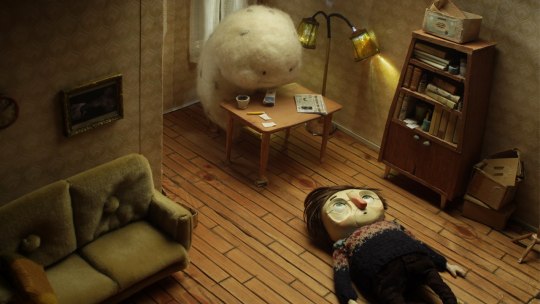
A still from ‘‘But Milk Is Important’ by Eirik Grønmo Bjørnsen and Anna Mantzaris
http://butmilkisimportant.blogspot.com/p/about.html The film website can be accessed through this link
The film runs for 11 minutes and is a light hearted, charming take on a story of paranoia and anxiety centring around the main character living with mental illness. Depicted through this otherworldly needle-felted creature. The main character has interchangeable faceplates to show his varying emotions throughout the piece.
“We are both very big fans of stop-motion and really like the aesthetics that the technique can offer”, admits Bjørnsen, “it was really important to us to keep a handmade feel but keep the quality as high as we could. The texture of different materials that can be captured in stop-motion is very valuable to us and we didn’t want to hide the fact that it is handmade. You can clearly see brush strokes and bits of cardboard here and there. Since atmosphere was important we also spent much time with camera settings and lighting to achieve the “right” feeling when setting up a scene”
5 notes
·
View notes
Photo
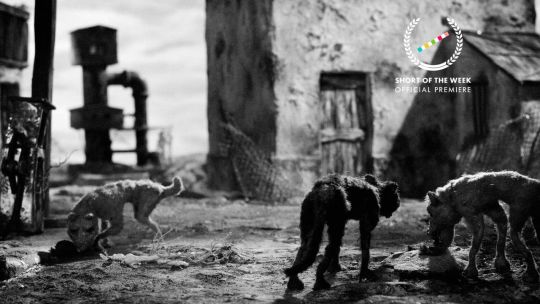
‘Canis’ by Marc Riba and Anna Solanas
This 17 minute animation focuses on a coming-of-age story set in a post-apocalyptic world, with canines roaming about. The storyline is very dark and bleak with scenes of death, the black and white colour palette dulling the colour of blood though the wetness of the material visually implies it. The narrative focuses on the protagonist: a young boy who has to survive in this brutal setting. This post apocalyptic setting relates to my research on stop-motion films troupe of depicting fantasy/ otherworldly settings and using puppetry as a tangible and realistic medium that is close enough to the tactility of reality, but far from true realism to portray it.
The filmmakers created the puppets out of balsa wood, wire and fabric taking them around 15 months. The canines are also needle-felted and look rough and scruffy as a stray would.
1 note
·
View note
Photo
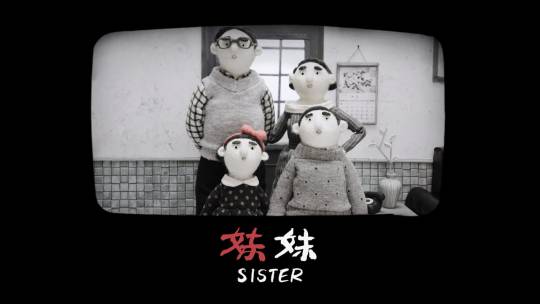
‘Sister’ by Siqi Song
This is a biographical piece where Song situates herself in the narrative through the eyes of her older brother. It is a story of familial relationship and shows the frustrations and milestones of a sibling bond. Set in 1990′s China during the height of the one-child-policy. It utilises needle-felted puppets with a desaturated colour scheme, though the colour red pops through the palette contributing to the sense of nostalgia.
0 notes
Photo
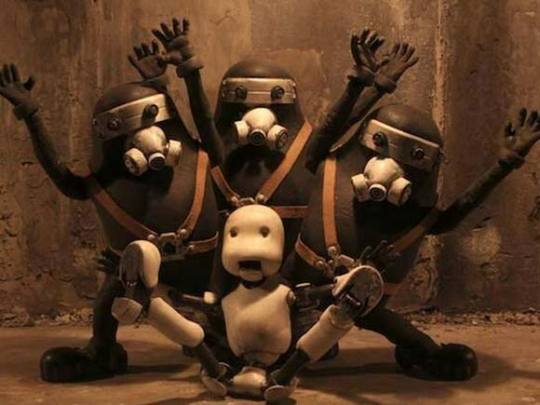
A still from ‘Junkhead 1′ by Takahide Hori
I remember watching a documentary of the process of this film on NHK World a couple years ago, I remember being fascinated by the scale of the set and intrigued by some of the grotesque puppet designs. I will see if it is online somewhere as I believe it went into depth of the creation of the film showing the artist’s process. This stop-motion piece is fascinating as it is 30 minutes long and heavily detailed, it is a labour of love as Takahide Hori spent four years of his spare time making this independent film, It is also his first time creating a stop motion piece. I feel It bares resemblance to Brother’s Quay with the navigation around a metallic and intriguing world composed of robotic like creatures. It makes use of some special effects in scenes and is set in a futuristic world, in which there is a human-mech hybrid considered by the other creatures as god-like, which relates to my relates to my research on narrative drawing parallels with religion and beliefs. It is also a story on global environmental destruction
The film won the ‘‘Best Animation’ award at 2014 Clermont-Ferrand International Short Film Festival
2 notes
·
View notes
Photo

A still from ‘‘Deer Flower’ by Kangmin Kim
Based on a terrible but ‘‘beautiful’ experience of his life in which he drinks deer blood as a child, the 8 minute film is composed of many 3D printed puppets which have been modelled in maya beforehand. Though the puppets are geometric and stylised, the lighting and sound effects add a sense of realism, it truly feels as though sunlight is hitting the puppets and casting shadows, there is also use of diegetic sound such as cicada’s chirping. There are many incredibly detailed zoom ins such as during the car journey where he inspects a mosquito on his arm with a magnifying glass.
0 notes
Photo
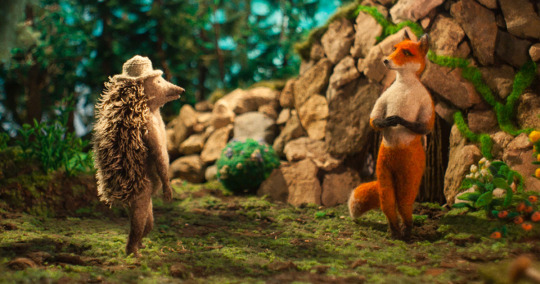
A still from ‘Hedgehogs Home’ by Eva Cvijanovic
Based on a children’s book of the same name, it’s classic and simple storytelling gives it a universal appeal. The needle felted style is also used in another stop motion short ‘Oh Willy...’ and to some extent Wes Anderson’s ‘Fantastic Mr. fox’ though these comparisons can be drawn Cvijanović and her team ensure their film has incredible attention-to-detail and enough individual touches to make it feel like an original, instead of an imitator.
It opens up with western style music and is narrated over with voice acting and a rhyming scheme. The short utilises ambient style lighting such as shifting to blue hues at night in the narrative. There is an interesting scene which bares resemblance to ‘Le Roman De Renard’ as a camera zooms up on the fox characters mouth dripping, I believe a scene like this is also used in ‘Fantastic Mr Fox’ it seems stories such as this with fox characters tend to share that troupe in stop-motion.
2 notes
·
View notes
Photo

Some notes I have made watching fairly recent stop-motion animation films on Shortoftheweek, as I am looking at puppetry as an enduring art form. Most of these examples have won awards for the medium, and some currently offline for the oscars.
‘Hedgehog’s Home’ (2017) By Eva Cvijanovic
‘Deer Flower’ (2016) By Kangmin Kim
‘Junk head’ (2013) By Takahide Hori
‘Sister’ (2018) By Siqi Song
‘Canis’ (2013) By Marc Riba and Anna Solanas
‘‘But Milk is Important’ (2012) By Eirik Grønmo Bjørsen and Anna Mantzaris
http://butmilkisimportant.blogspot.com/p/about.html
‘‘Negative Space’ (2017) By Ru Kuwahata and Max Porter
Recent puppetry stop-motion films tend to use needle felted puppets, as used in ‘Hedgehog’s Home’, ‘Sister’, ‘Canis’ and ‘‘But Milk Is Important’ usually for the fur of animals with the exception of ‘Sister’. The use of needle felted texture often results in sporadic movement though it doesn’t look incongruous in stop-motion, instead it feels natural as though the surface is moving with the wind of the setting. ‘Deer Flower’ uses 3D printed paper puppets for the short film, which looks incredibly detailed and geometric, it ties in the puppets to their surroundings. Shortoftheweek showcases short films from different countries so it is interesting to see that new stop-motion isn’t biased to one country in popularity and the quantity of work. Out of the few I have looked at the work has come from; Norway, China, Japan, Spain, South Korea and Canada. Which is also interesting to see some mediums such as needle felting being used in across countries. It is also really inspiring to see the animations winning, and being nominated for awards, thus showing the appreciation for the medium.
0 notes
Link
0 notes
Link
1 note
·
View note
Link
This is another animation I recently found by Roman Kachanov, it’s interesting to see it was made in 1972 as it looks of a similar style to modern animation, it is a story of maternal love and a mothers fear for leaving a child on their own. There is no dialogue though there is some diegetic sound of objects and some contrapuntal easy listening jazzy music.
0 notes
Text
Animism
I have also been reading ‘Animating Film Theory’ by Karen Beckman over the summer, Which makes mention of different theories/beliefs in relation to animation that I can apply in my studies such as animism. Animism is a global belief that objects, places and creatures can possess a distinct spiritual essence, animistic faiths are some of the oldest religions and beliefs, the Japanese Shinto folk religion is an example, in the 70′s American companies like Ford tried to sell cars in Japan but struggled, after investigating they found out that it was because they believed the cars looked ‘sad’ in their design, though the book is mostly focused on 2D animation techniques this belief can relate into the spirit and life that the animated puppet can evoke in stop-motion and that added level of realism in the film which can help situate the audience in relation to the character/story.
0 notes
Text
Themes of Eastern European Stop-Motion Films
Theses by Choi Youkyung: https://search.proquest.com/docview/1684021691?pq-origsite=primo This thesis explains the order and events that developed stop-motion techniques in Eastern Europe, and the historical/political effect on a group of stop-motion animators and the animations they produced, it also mentions the uprising of stop-motion in the US with the influence of these animators.
Stop-motion animation flourished in the Czech Republic in its golden age of the 50′s- 60′s with a long tradition of puppetry and cultural tendency towards surrealism. The soviet war was formed at the end of the civil war and many artists were commissioned in the Soviet Union to produce work to propagate socialist ideas. In the early twentieth century the first film camera was invented and experimentation with stop-motion began, starting with Ladislas Starevich’s ‘the battle of the stag beetles’ (1910).
While artists experimented with stop-motion in Europe, it was being used in the US with Willis O’Brien who mixed live action with stop motion. George Pal also gathered recognition in Europe and America, he opened his own cartoon studio where he tried stop-motion for a cigarette company commercial, one of his works include ‘‘Tulips shall grow’ (1942) which criticised Germany’s envision of the Netherlands. Rankin/Bass productions were active from the 60′s- 80′s they worked for commercials however they wanted to focus on exclusively animation production so they visited Japan in 1958 to learn about their animation industry, this is where they hired Tadahiro Mochianaga who was a pioneer of Japanese stop-motion animation and his early apprentices includes Kihachiro Kawamoto (mentioned in my previous post) with Mochianaga Rankin’s stop-motion work included ‘The New Adventures of Pinocchio’ (1960) and ‘The Daydreamer’ (1966).
Whilst stop motion reached the US public through television, censorship and nationalisation of the film industry were affecting artists in the Soviet Union, pro-Stalinist Brezhnev came to power from ‘64 to ‘82. In the 60′s artists were banned and censored however in the 70′s they were exiled, deported or placed under house arrest, it was severe for filmmakers but animators could slip under the officials eyes. In ‘61 Yuri Norstein started his animation career at Soyuzmultfilm- one of the most influential animation production companies, his animations include layers of painted thick glass for three dimensional effects. He was inspired by Turkish poet Nazim Hikmet’s Tale of Tales and proposed production for an animation explaining it was about a poet who could not write, but as production began it shaped into a realistic depiction of Russia after World War Two based on his childhood memories, Soviet Officials forbade him from travelling for screenings as they didn’t want it to be shown to the public. As previously mentioned in my blog and timeline; Trnka and Švankmajer we’re also able to place political and social meanings into their animation work with consequences such as Trnka’s films being banned and Švankmajer’s ban from filmmaking from 72-79
Jiří Barta followed Švankmajer in the 80′s, after the Soviet Union’s collapse in ‘89 artists could express themselves free of censorship however government financial support ceased and so did Soyuzmultfilm in Russia, animators switched to different jobs to live easier whilst in the US stop-motion animation boomed with Tim Burton’s “The Nightmare Before Christmas” which was one of the first Stop-motion films to have such a big budget and specialist crew behind it.
1 note
·
View note
Photo



https://search.proquest.com/docview/1777508497?accountid=12118&rfr_id=info%3Axri%2Fsid%3Aprimo
This article above on Kawamoto’s ‘Dojoji Temple’ links heavily to what I have been researching with links to Czech animation, similar folklore to Geng Xue’s ‘Mr. Sea’ (2014) and some insight into Japanese and Czech puppetry rich tradition.
“Dojoji Temple” (1976) is a short puppet stop-motion animation directed by Kihachiro Kawamoto, who’s influences include Japanese myth, Bunraku (Japanese puppet plays) and Emaki (painted scrolls). Similar to “Mr. Sea” the story involves woman who transforms into a sea-serpent, the story is of a woman’s unrequited love for a young priest, heartbroken she transforms into a sea serpent and seeks revenge. Kihachiro Kawamoto is influenced by Japanese medieval arts and Czech stop-motion techniques, his interest in animation led him to Czechoslovakia where he explored the stop-motion technique under the mentor of Jiri Trnka, in an interview Kawamoto said “the reason why I was so into Trnka’s animation was that he was able to tell a story in a poetic style through the use of puppets”. Some of his works include;
“Oni” The Demon (1972)
“Shijin no Shogai” A Poet’s Life (1974)
“Kataku” House of Flame (1979)
“Fusha no Sha” to shoot without shooting (1988)
Dojoji temple is a tale of sorrow about a young priest/monk that’s stops at an inn on his travels, where a young woman falls in love with him and confesses her feelings, the monk rejects her but makes a promise with a Buddha statue that if she waits for him, he will return, the promise was a lie and when she finds out she seeks revenge transforming into a sea-serpent. The puppets have limited facial expressions as what is engraved stays permanent, unlike ‘the nightmare before christmas’’ Jack who had over 400 different removable heads, the muted expression has influence from Czech puppetry and the tradition of Bunraku puppet theatre, the faces remain the same so the emotion lies in the body gestures of the puppets.
The article also mentions how the character’s emotions are depicted through the iconography and non-verbal messages in their movement and the cinematography, such as the light on the maidens face giving two meanings, one of a new thought/idea (the discovery that she has been lied to) and the shadow it casts which highlights the eyes showing her rage, the iconography of her shawl signifies her dignity remains. Greek and Indian mythology is also referenced in her transformation into a sea-serpent with the idea of a goddess in many mythological examples where a god becomes human in order to test human spirit, in Japanese the term for this spirit is called ‘Kami’. The sea-serpent transformation is also referenced in Chinese folklore with the ‘killing the serpent’ folk story from the Qing Dynasty.
2 notes
·
View notes
Photo


https://search.proquest.com/docview/2164964107?accountid=12118&rfr_id=info%3Axri%2Fsid%3Aprimo
Geng Xue is an interesting artist I found out about in the article above, she has a long standing tradition of ceramic practice and explores the potential of ceramics in stop-motion, she stated her preference of the material traces back to her passion for Chinese traditional art, which porcelain carries a long history.
Her short film ‘Mr Sea’ (2014) pictured above took an entire year to make, the film is based on a classic Qing Dynasty ghost story originally titled as ‘killing the serpent’ the story revolves around a young man arriving on a remote island in search of peace, the world is depicted through perfect porcelain, until lumps of clay appear and change form into porcelain, such as of an elixir and a woman in a red cloak, the woman successfully seduces the man and her porcelain body breaks as she transforms into a sea serpent that feeds off the blood of the man, his blood ends up poisoning the serpent because of the elixir he drank. The storyline reflects ancient Chinese beliefs in the world of magic as “ a real place, where beautiful things could become monsters in the blink of an eye” echoed in the transformations that take place in the film and amplified by the interplay of light and shade, the mist and swirling smoke. The glossiness and lightness of the porcelain characters creates a dream like atmosphere. This animation also conforms to the technique of puppetry and stop-motion suiting otherworldly settings.
0 notes
Photo

A collection of visuals from some of the animations I have found, also on my sutori timeline.
0 notes